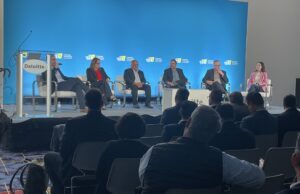
Software is shaking up vehicle manufacturing, CES panel says
By onAnnouncements | Technology
Collaboration is key between OEMs and suppliers as rapidly changing software becomes a more critical piece of vehicle manufacturing, a panel of experts at the Consumer Electronics Show (CES) said.
Elmar Pritsch, partner at Deloitte Consulting, started “The New Age of Auto – from Steel & Exhaust to Software & Sustainability” discussion by noting vehicles today, on average, have 40 times more lines of code than the 2.6 billion lines of code in a Boeing 777.
“So there must be a meaning behind the software,” Pritsch said.
Sanjiv Khurana, with the connectivity services group for Daimler Truck, said companies need to stay up-to-date with the latest technology advancements, including autonomous and zero-emission vehicles.
“There’s a clear need for us to move beyond what we do today in terms of providing trucks and buses and move towards providing service solutions which are based on software,” Khurana said.
As technical advancements move quickly, so must the industry, he said.
“We are changing the way we develop our digital products,” Khurana said. “And that’s certainly something different and new for us. Traditionally, we think about product development in long cycle times. And as we look at our digital products, we have to adapt to the agile approach and look at ways to speed up our development.”
Khurana said that, typically, changing something on a truck could take months or years, but changing technology, such as something on an application, can be completed in days or weeks.
Khurana added, “How do we improve that speed to offer new services and solutions?”
ABI Research predicts that by 2028 U.S. automakers will shift to over-the-air (OTA) recall remedies to save $1.5 billion a year. ABI added that OTA capability will allow OEMs to mitigate recalls by pushing updates before a recall becomes necessary without driver intervention.
Pritsch said more OEMs are taking a “risk” on developing their own software.
Last year, Ford announced the hiring of Apple’s Vice President of Services Peter Stern to lead software-enabled experiences. Mike Abbott, another former Apple executive, was named as GM’s executive vice president of software.
“Usually OEMs design and build, while the suppliers provide the components and software and now we hear more and more OEMs are taking a look at the software,” Pritsch said. “How do you cope with the situation?”
Mariella Minutolo, ETAS–Bosch executive vice president of sales, said decoupling hardware and software has been a focus of the industry in recent years.
“We’re not there yet and aren’t able to say, ‘We as an industry have found a solution to have it all and be successful in software,'” Minutolo said. “We need collaboration and decoupling of software and hardware is one step to really enable collaboration across the industry.”
Bosch recently developed a new vehicle motion management system that needed collaborative work from different departments to oversee steering, braking, and the powertrain, Minutolo said. Everyone working together created a stable and safe braking solution, she said.
Andrew Pollak, Panasonic Automotive chief technology officer, echoed Minutolo’s thoughts on decoupling.
“Some people, they would think, were well into software-defined vehicles,” Poliak said. “But realistically, there’s still a shift that needs to take place, and we’re still in the early days of OEMs and Tier Ones moving to that shift — moving from hardware first and hardware-focused manufacturing to software-driven innovation.”
However, the shift is happening because OEMs have to adapt quickly to the speed of technology, he said.
“You can’t just launch something and expect 11 years later that it will still be relevant without some way of embracing not just software, but even hardware upgradeability,” Poliak said.
Decoupling allows you to start working on software instead of waiting for the hardware to be complete, he said.
“You mentioned that millions of lines of code that are in these systems,” Pollak said referring to Pritsch’s first statements, “The integration effort — the development effort — cannot wait until you have your first sample hardware.”
Poliak said OEMs still need suppliers to help with software.
“OEMs are doing more software development,” Poliak said. “But I think that talent gap is going to be a real problem if they try to do all of it.”
Bill Pinnell, Qualcomm vice president and head of automotive software product management, said more than ever, the industry sees that an ecosystem of suppliers is essential to ensure technology works.
“You can’t rely on just Android,” Pinnell said. “You can’t rely on just Amazon for something. You need a pool of ecosystem providers.”
Images
Elmar Pritsch, Missy Stigall, Andrew Poliak, Bill Pinnell, Sanjiv Khurana, and Mariella Minutolo speak at CES 2024 on Jan. 9. (Teresa Moss/Repairer Driven News).
